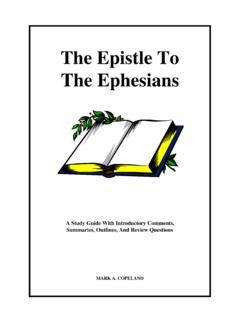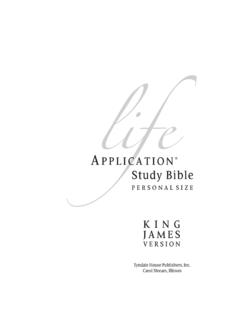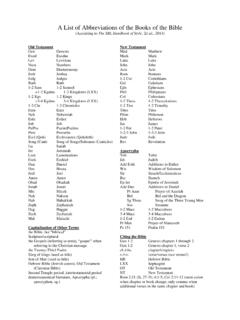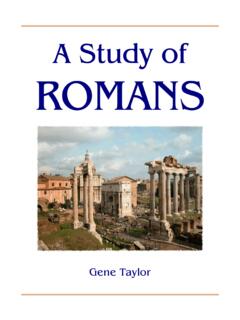Transcription of Third Sunday of Advent – 12 December 2021
1 Third Sunday of Advent Third Sunday of Advent 12 December 2021. The Faith Nurture Forum would like to thank Revd Professor Charlotte Methuen, Professor of Ecclesiastical History, University of Glasgow, Assistant Priest at St Margaret Newlands, SEC, Convener of the SEC Inter-Church Relations Committee, for her thoughts on the Third Sunday of Advent . Weekly Worship, based on the Revised Common Lectionary, is for everyone in any capacity who is involved in creating and leading worship. It provides liturgical material that can be used for worship in all settings. Our writers are asked to share their approaches to creating and delivering this material to equip leaders with a greater confidence and ability to reflect on their own worship practice and experience and encourage them to consider how this material might be adapted for their own context.
2 We would encourage continual reflection on the changing patterns of worship and spiritual practice that are emerging from disruption and how this might help identify pathways towards development and worship renewal. We may not all be gathered in the same building, but at this time, when we need each other so much, we are invited to worship together, from where we are knowing that God can hear us all and can blend even distant voices into one song of worship. Introduction .. 3. Zephaniah 3:14-20 .. 3. Isaiah 12:2-6 .. 4. philippians 4:4-7 .. 5. Luke 3:7-18 .. 6. Sermon ideas .. 7. Prayers .. 8. Alternative Material post COP26 ..12. Musical suggestions ..22. Reflecting on our worship practice.
3 23. Useful links ..25. Introduction Advent is the period of preparation leading up to Christmas, in the same way that Lent is the prayer of preparation leading up to Easter. It is the season in which we prepare to celebrate the incarnation whilst also reflecting on the Christ's second coming and therefore on the end of the world. As a season of preparation it is also a penitential season, which is why the liturgical colour is purple. This can sit somewhat uncomfortably with the busyness of preparing for Christmas, especially if people are already caught up in a round of Christmas parties, Christmas lunches and carol services. One of the challenges, as Paula Gooder puts it so well in The Meaning Is in the Waiting: The Spirit of Advent (2010), is to keep a sense of anticipation, in the sense of waiting, rather than anticipating Christmas by beginning to celebrate it during Advent , or even earlier.
4 (When did you see the first Christmas tree this year or hear your first Christmas carol? Christmas chocolates appeared in German shops the first weekend in October, as I was preparing this material.). How do we keep the focus on preparation? One way is to think carefully about what music to use, keeping to Advent carols and hymns rather than choosing Christmas carols in the run up to Christmas. Another is to use an Advent wreath, lighting one candle each Sunday through Advent and a fifth Christ candle on Christmas morning. The sequence of Advent 1, The Patriarchs; Advent 2, The Prophets; Advent 3, John the Baptist; Advent 4, The Virgin Mary gives a pattern to Advent which also offers an overview of salvation history.
5 Another tradition of naming the candles on the Advent wreath sees them as representing hope, love, joy and peace (or hope, peace, love, joy, or various other orders! Be careful when choosing resources to make sure they match). Advent 3 is Gaudete Sunday : Rejoice! For that reason it may have a pink candle. It is named after the first word of the Latin translation of philippians 4:4, the introit traditionally set for this Sunday : Rejoice in the Lord always! Again I say rejoice! (Gaudete in Domino semper: iterum dico, gaudete.) The juxtaposition of the exhortation Rejoice! , which permeates the readings from Zephaniah and philippians , with John the Baptist's words of warning in the gospel reading ( You brood of vipers!)
6 Bear fruits worthy of repentance! ). may provide food for thought in preparing worship and preaching for Advent 3. Zephaniah 3:14-20. The Old Testament lesson is full of rejoicing. Zephaniah, a prophet associated with the reign of King Josiah, proclaims the time of redemption, the time in which all Israel's sins will be forgiven and God will remove disaster, deal with oppressors, save the lame and gather the outcast. Commentators point out, however, that this explosion of joy comes at the end of a book which is characterised by doleful prophesies and dire warnings. The majority of the book is taken up by what Carol Dempsey describes as proclamations of judgment and imminent disasters (1:2 - 3:8): against Jerusalem and Judah, Philistia, Moab and Ammon, Ethiopia, and Assyria, followed by God's reproach against Jerusalem.
7 Then comes God's promise of future purification (3:8-13), culminating with the proclamation of hope, salvation, and restoration that forms today's reading (3:14-20).[1] Zephaniah depicts God as completely disgusted with Judah and Jerusalem because of their false and sensual worship (1:4-6; 3:1-5) and is enraged with the nations because of their unjust treatment of Judah (2:8) and their corrupt deeds (3:7). However, the rage and fury eventually dissipate as daughter Zion looks forward to salvation and restoration in the sight of all peoples. [2] The joy and rejoicing expressed in today's reading are in that sense a response to a period of difficulty and trauma in which the people of Judah felt cut off from or rejected by God.
8 This might be an angle to explore against the backdrop of recent experiences such as the pandemic, petrol shortages and supply chain issues, and in the awareness that increasing numbers of people are experiencing mental health issues or a deep sense of isolation. What does redemption look like in these circumstances? What would cause us to rejoice? What would truly change our lives for the better? [1] Carol J. Dempsey, Amos, Hosea, Micah, Nahum, Zephaniah, Habakkuk (Collegeville, MN: Liturgical Press, 2013), introduction [2] Ibid Isaiah 12:2-6. The psalm is replaced today by a canticle drawn from the First Isaiah ( Isaiah 1-39). G rard Nissim Amzallag argues that this canticle can best be understood as a text intended to be sung antiphonally, where the first part of each line is given in verses 1-3 and the response in verses 4-6.
9 [3] (It would therefore be preferable to use the whole chapter, Isaiah 12:1-6, rather than beginning at verse 2.) Amzallag arranges the canticle thus (his translation, slightly amended with the responses in italics): You will say on that day: // And you will say on that day: I give you praise in singing, YHWH // Praise YHWH in singing, Call upon his name;. for though you were angry with me, // make known his deeds among the nations;. your anger was turned away, and you comforted me // proclaim that his name is exalted. Surely God is my salvation; // Sing praises to the Lord, I will trust, and will not be afraid, // for his glorious deeds;. For my strength and my song is YHWH; // let this be known and he has become my salvation.
10 // in all the earth. You will draw water with joy // Shout and sing for joy, O inhabitant of Zion, From the wells of salvation. // For great in your midst is the Holy One of Israel.[4]. As with Zephaniah, Isaiah 12 concludes a series of prophetic warnings with a song of hope, which also has an eschatological dimension. Amzallag finds that Isaiah 12 also points forward to themes that will be central to Second Isaiah, or Deutero-Isaiah (Isaiah 40 55), the source of many of the Old Testament readings associated with the Christmas season. Isaiah 12 affirms that the blind destruction unleashed by the divine anger is none other than the first stage of a process that culminates with the emergence of an improved reality.





